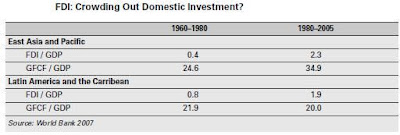It is expected that the level of foreign investment has a direct positive relationship with stimulation of investment and hence the economy in a given investment-deficient country. Actually, in reality this depends on whether FDI acts as a complement (crowd in) or substitute (crowd out) to the level of domestic investment in an economy. (more below)
A study (Foreign Investment and Sustainable Development: Lessons from the Americas) by the Working Group on Development and the Environment in the Americas finds that foreign investment has fallen short of stimulating “broad-based” economic growth and sustainable development in Latin America. The working group studies the impact of foreign investment on economic growth, environment policy, and the political economy of Argentina, Brazil, Bolivia, Chile, Costa Rica, Ecuador, Mexico, Uruguay, and Venezuela.
They studied various regional and bilateral agreements like NAFTA, US-Chile FTA, CAFTA, US-Peru FTA, etc and looked at the impact of investment liberalization (a part of the Washington Consensus) on the Americas. What did they find? This wave of liberalization that started in the 1990s did not produce significant results as was expected. Economic growth in per capita terms in the region was slower than in the final decades of the import substitution period, according to the report.
Major findings of the report:
-
80% of all the FDI was concentrated in Brazil, Argentina, Chile, and Venezuela.
-
Foreign firms in Mexico were export platforms to the US and those in the South America tended to sell in their own domestic market.
-
Foreign firms tended to have higher level of productivity and higher wages.
-
FDI fell short of generating spillovers and backward linkages that could help stimulation of domestic economy through emergence of local small and medium sized businesses. In fact, FDI tended to displace and kill local businesses. R&D expenditures in the host economies were not upped.
-
Environmental performance of foreign firms was mixed, sometime better and sometimes worse performance than domestic counterparts.
Note that the report does not label that the FDI’s impact on economic growth and environmental sustainability was a complete flop- it had a limited success in Latin American countries. There are cases where FDI has been a crucial factor behind rising economic growth like in China, South Korea, Bhutan, Taiwan, Malaysia, Singapore, and Mauritius, among others. The report slides in a space where there is always a trade off between growth objectives and impact on environment arising from increasing investment (both domestic and FDI). Cost is always high when considering the impact of an investment plan in an environmentally conscious manner.
Important lessons from the Latin American experience:
-
FDI is not an end but a means to sustainable development. Simply attracting FDI is not enough to generate economic growth in an environmentally sustainable manner.
-
FDI policy needs to be paired with significant and targeted domestic policies that upgrade the capabilities of national firms and provide a benchmark of environmental protection.
-
There needs to be policy space to accommodate domestic concerns in international agreements.
One of the lessons from the report is that FDI does not necessarily crowd in domestic investment. Actually, the impact of FDI on domestic investment is mixed. In Latin America, FDI has in crowed out domestic investment, as shown by this report, but in Asia (East Asia especially) and Africa, FDI has led to crowding in of domestic investment. FDI tend to be a substitute for domestic investment when there are lot of domestic firms. Meanwhile, FDI tend to be complementary when there are few domestic firms (whole sorts ancillary firms will emerge because of R&D and knowledge spillovers from MNCs). The existence of backward and forward linkages from the establishment of foreign investors is a key consideration for determining the total impact of FDI on capital formation.

Background working papers leading to the report are available here.
